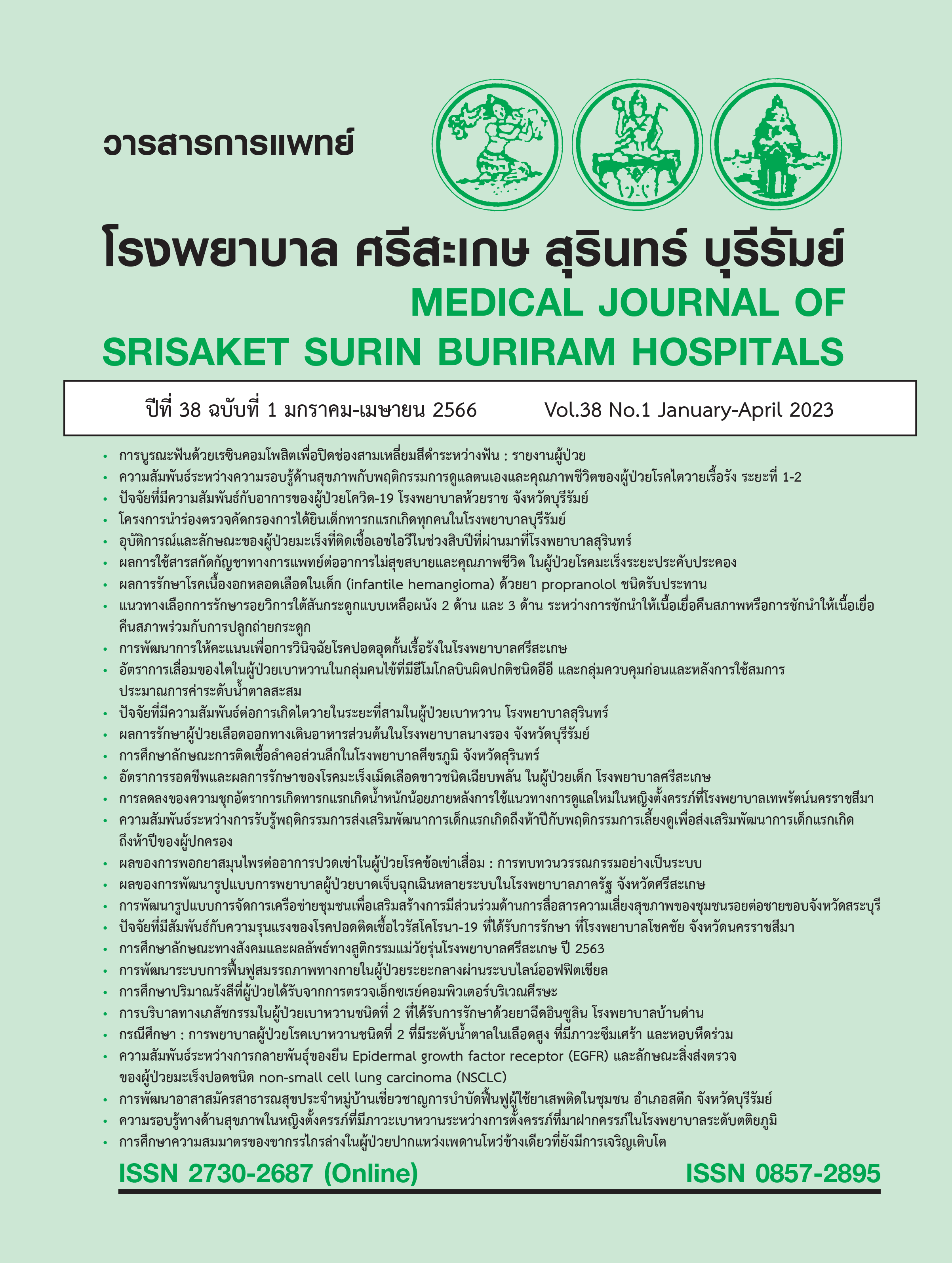ผลการรักษาโรคเนื้องอกหลอดเลือดในเด็ก (infantile hemangioma) ด้วยยา propranolol ชนิดรับประทาน
Main Article Content
บทคัดย่อ
หลักการและเหตุผล: เนื้องอกหลอดเลือดเป็นเนื้องอกชนิดไม่รุนแรงที่พบมากที่สุดในเด็ก สามารถยุบได้เอง ในรายที่มีภาวะแทรกซ้อนในปัจจุบันมีการนำยา propranolol มารักษาพบว่าได้ผลดี แต่ยังมีข้อมูลการรักษาด้วยยา propranolol ในประเทศไทยค่อนข้างน้อย
วัตถุประสงค์: เพื่อศึกษาผลการรักษาและผลข้างเคียงของยา propranolol ในการรักษาโรคเนื้องอกหลอดเลือด
วิธีการศึกษา: เป็นการศึกษา cross-sectional study design ในผู้ป่วยที่ได้รับการวินิจฉัยว่าเป็นโรคเนื้องอกหลอดเลือดที่ผิวหนัง อายุตั้งแต่แรกเกิด - 3 ปีที่มารับการรักษาที่โรงพยาบาล ศรีสะเกษ วันที่ 1 กรกฎาคม พ.ศ. 2564 – 30 มิถุนายน พ.ศ. 2565 โดยให้ยา propranolol 2 mg/kg/day วิเคราะห์ข้อมูลโดยประเมินเป็นร้อยละของการเปลี่ยนแปลงขนาดเปรียบเทียบกับก่อนทำการรักษาด้วยวิธี photograph base visual analog scales
ผลการศึกษา: มีผู้ป่วยทั้งหมดจำนวน 11 ราย อัตราส่วนเพศชายต่อเพศหญิง 1:2.7 มีอายุระหว่าง 2-23 เดือน (เฉลี่ย 10±8.7 เดือน) เป็นทารกเกิดก่อนกำหนด 5 ราย (ร้อยละ 45.5) พบตำแหน่งเนื้องอกหลอดเลือดบริเวณใบหน้าและศีรษะมากที่สุด 8 รอยโรค (ร้อยละ 72.7) ผู้ป่วยทุกรายตอบสนองต่อการรักษา ระยะเวลาที่รับประทานยาตั้งแต่ 3-15 เดือน (เฉลี่ย 10.6±3.3 เดือน) ไม่มีผู้ป่วยที่มีขนาดรอยโรคโตขึ้นหลังหยุดยา ไม่พบผลข้างเคียงจากยา พบว่าผู้ป่วยที่เริ่มรักษาอายุน้อยจะตอบสนองต่อการรักษาเร็วกว่ากลุ่มที่เริ่มรักษาขณะอายุมากอย่างมีนัยสำคัญทางสถิติ (P < 0.01)
สรุป: propranolol เป็นยาที่มีประสิทธิภาพสูงในการรักษาโรคเนื้องอกหลอดเลือด ผลข้างเคียงน้อย จึงควรใช้เป็นยาทางเลือกแรกและควรเริ่มให้การรักษาตั้งแต่อายุน้อยจะให้ผลการรักษาดีกว่า
Article Details

อนุญาตภายใต้เงื่อนไข Creative Commons Attribution-NonCommercial-NoDerivatives 4.0 International License.
เอกสารอ้างอิง
Krowchuk DP, Frieden IJ, Mancini AJ, Darrow DH, Blei F, Greene AK, et al. Clinical Practice Guideline for the Management of Infantile Hemangiomas. Pediatrics 2019;143(1):e20183475. doi: 10.1542/peds.2018-3475.
Anderson KR, Schoch JJ, Lohse CM, Hand JL, Davis DM, Tollefson MM Increasing incidence of infantile hemangiomas (IH) over the past 35 years: Correlation with decreasing gestational age at birth and birth weight. J Am Acad Dermatol 2016;74(1):120-6. doi: 10.1016/j.jaad.2015.08.024.
Munden A, Butschek R, Tom WL, Marshall JS, Poeltler DM, Krohne SE, et al. Prospective study of infantile haemangiomas: incidence, clinical characteristics and association with placental anomalies. Br J Dermatol 2014;170(4):907-13. doi: 10.1111/bjd.12804.
Drolet BA, Frommelt PC, Chamlin SL, Haggstrom A, Bauman NM, Chiu YE, et al. Initiation and use of propranolol for infantile hemangioma: report of a consensus conference. Pediatrics 2013;131(1):128-40. doi: 10.1542/peds.2012-1691.
Sans V, de la Roque ED, Berge J, Grenier N, Boralevi F, Mazereeuw-Hautier J, et al. Propranolol for severe infantile hemangiomas: follow-up report. Pediatrics 2009;124(3):e423-31. doi: 10.1542/peds.2008-3458.
Price CJ, Lattouf C, Baum B, McLeod M, Schachner LA, Duarte AM, et al. Propranolol vs corticosteroids for infantile hemangiomas: a multicenter retrospective analysis. Arch Dermatol 2011;147(12):1371-6. doi: 10.1001/archdermatol.2011.203.
Sethuraman G, Yenamandra VK, Gupta V. Management of infantile hemangiomas: current trends. J Cutan Aesthet Surg 2014;7(2):75-85. doi: 10.4103/0974-2077.138324.
Techasatian L, Phukam N. Treatment Modalities and Outcomes of Infantile Hemangiomas at Srinagarind Hospital. J Med Assoc Thai 2016;99 Suppl 5:S74-80.
Smith CJF, Friedlander SF, Guma M, Kavanaugh A, Chambers CD. Infantile Hemangiomas: An Updated Review on Risk Factors, Pathogenesis, and Treatment. Birth Defects Res 2017;109(11):809-15. doi: 10.1002/bdr2.1023.
Callahan AB, Yoon MK. Infantile hemangiomas: A review. Saudi J Ophthalmol 2012;26(3):283-91. doi: 10.1016/j.sjopt.2012.05.004.
Ainipully AM, Narayanan SK, Vazhiyodan AP, Somnath P. Oral Propranolol in Infantile Hemangiomas: Analysis of Factors that Affect the Outcome. J Indian Assoc Pediatr Surg 2019;24(3):170-5. doi: 10.4103/jiaps.JIAPS_12_18.
Léauté-Labrèze C, Dumas de la Roque E, Hubiche T, Boralevi F, Thambo JB, Taïeb A. Propranolol for severe hemangiomas of infancy. N Engl J Med 2008;358(24):2649-51. doi: 10.1056/NEJMc0708819.
Haggstrom AN, Garzon MC, Baselga E, Chamlin SL, Frieden IJ, Holland K, et al. Risk for PHACE syndrome in infants with large facial hemangiomas. Pediatrics 2010;126(2):e418-26. doi: 10.1542/peds.2009-3166.
Drolet BA, Frommelt PC, Chamlin SL, Haggstrom A, Bauman NM, Chiu YE, et al. Initiation and use of propranolol for infantile hemangioma: report of a consensus conference. Pediatrics 2013;131(1):128-40. doi: 10.1542/peds.2012-1691.
Love JN, Sikka N. Are 1-2 tablets dangerous? Beta-blocker exposure in toddlers. J Emerg Med 2004;26(3):309-14. doi: 10.1016/j.jemermed.2003.11.015.
Prey S, Voisard JJ, Delarue A, Lebbe G, Taïeb A, Leaute-Labreze C, et al. Safety of Propranolol Therapy for Severe Infantile Hemangioma. JAMA 2016;315(4):413-5. doi: 10.1001/jama.2015.13969.
Stringari G, Barbato G, Zanzucchi M, Marchesi M, Cerasoli G, Tchana B, et al. Propranolol treatment for infantile hemangioma: a case series of sixty-two patients. Pediatr Med Chir 2016;38(2):113. doi: 10.4081/pmc.2016.113.
Ji Y, Chen S, Yang K, Zhang X, Zhou J, Li L, et al. Efficacy and Safety of Propranolol vs Atenolol in Infants With Problematic Infantile Hemangiomas: A Randomized Clinical Trial. JAMA Otolaryngol Head Neck Surg 2021;147(7):599-607. doi: 10.1001/jamaoto.2021.0454.
Léauté-Labrèze C, Hoeger P, Mazereeuw-Hautier J, Guibaud L, Baselga E, Posiunas G, et al. A randomized, controlled trial of oral propranolol in infantile hemangioma. N Engl J Med 2015;372(8):735-46. doi: 10.1056/NEJMoa1404710.
Shah SD, Baselga E, McCuaig C, Pope E, Coulie J, Boon LM, et al. Rebound Growth of Infantile Hemangiomas After Propranolol Therapy. Pediatrics 2016;137(4):e20151754. doi: 10.1542/peds.2015-1754.


